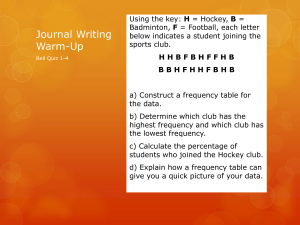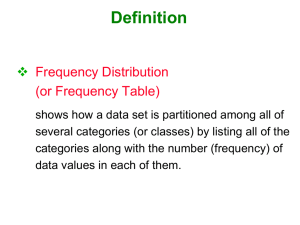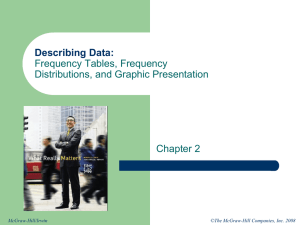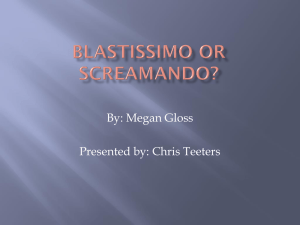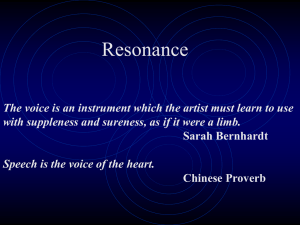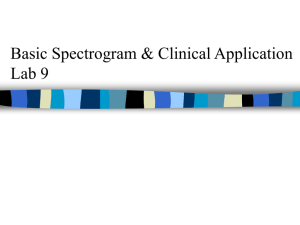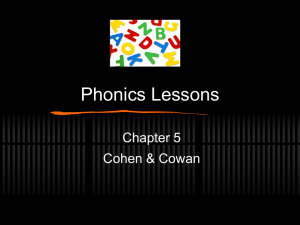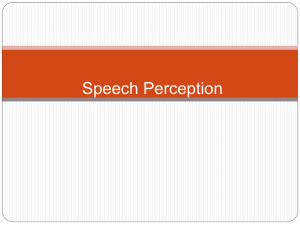Document
advertisement
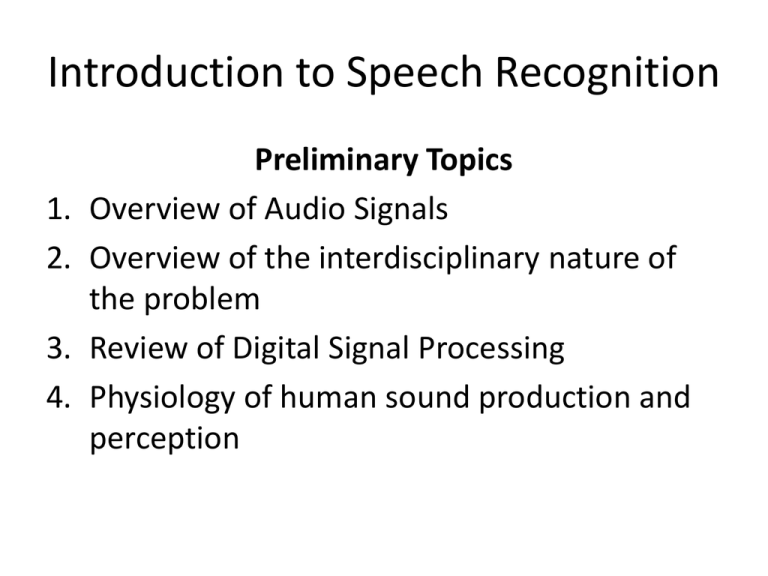
Introduction to Speech Recognition
1.
2.
3.
4.
Preliminary Topics
Overview of Audio Signals
Overview of the interdisciplinary nature of
the problem
Review of Digital Signal Processing
Physiology of human sound production and
perception
Science of Language
•
•
•
•
•
•
Morphology: Language structure
Acoustics: Study of sound
Phonology: Classification of linguistic sounds
Semantics: Study of meaning
Pragmatics: How language is used
Phonetics: Speech production and perception
Natural Language Processing draws from these fields to
engineer practical systems that work.
Language Components
• Phoneme: Smallest discrete unit of sound that
distinguishes words (Minimal Pair Principle)
• Syllable: Acoustic component perceived as a
single unit
• Morpheme: Smallest linguistic unit with meaning
• Word: Speaker identifiable unit of meaning
• Phrase: Sub-message of one or more words
• Sentence: Self-contained message derived from a
sequence of phrases and words
Natural Language Characteristics
• Phones are the set of all possible sounds that
humans can articulate. Each phone has unique audio
signal characteristics.
• Each language selects a set of phonemes from the
larger set of phones (English ≈ 40). Our hearing is
tuned to respond to this smaller set.
• Speech is a highly redundant sequential sequence of
sounds (phonemes) , pitch (prosody), gestures, and
expressions that vary with time.
Audio Signal Redundancy
• Continuous signal (virtually infinite)
• Sampled
–
–
–
–
–
–
–
Mac: 44,100 2-byte samples per second (705kbps)
PC: 16,000 2-byte samples per second (256kbps)
Telephone: 4k 1-byte sample per second (32kbps)
Code Excited Linear Prediction (CELP) Compression: 8kbps
Research: 4kbps, 2.4 kbps
Military applications: 600 bps
Human brain: 50 bps
Sample Sound Waves (Sound Editor)
Download and install from ACORNS web-site
Top: “this is a demo”
Bottom: “A goat …. A coat”
Time domain
Complex Wave Patterns
• Sound waves occupying the
same space combine to form a
new wave of a different shape
• Harmonically related waves
add together and can create
any complex wave pattern
• Harmonically related waves
have frequencies that are
multiples of a basic frequency
• Speech consists of sinusoids
combined together mostly by
linear addition
Nyquist Theorem
What is the optimal sample rate for speech?
Nyquist Frequency (fN) = highest detectible frequency
Sampling Frequency (fs) = samples per time period
Maximum Signal Frequency (fmax)
Theorem: fN = 2 * fmax; fs >= fN
Inadequate Sampling
Adequate Sampling
Most speech information is below 4 kHz, human perception is below 22khz
Telephone speech is sampled at 8 kHz, computer algorithms sample ≤ 44 kHz
Audio File Formats
• Amplitude measurements in samples/second stored in an array
• Wav File format - Pulse Code Modulation (PCM)
– Usually 2 bytes per sample (can be 3 or 4 bytes per sample)
– Big or Little Endian
– Single or Stereo channels
• Ulaw and Alaw
– Takes advantage of human perception which is logarithmic
– One byte per sample containing logarithmic values
• Compression algorithms code speech differently, but we
convert to PCM for processing
– Examples: spx, ogg, mp3
– Algorithms: Run length compression, Linear prediction coding (CELP)
• Java Sound and Tritonus support various formats/conversions
Time vs. Frequency Domain
Time Domain: Signal is a composite wave of different frequencies
Frequency Domain: Split time domain into the individual frequencies
Fourier: We can compute the phase and amplitude of each composite sinusoid
FFT: An efficient algorithm to perform the decomposition
Formant
“a” from “this is a demo”
• Formant: The spectral peaks of the sound spectrum, or harmonics of the
fundamental frequency
• Harmonic: A wave whose frequency is a integral multiple of that of a
reference wave
• F0 or fundamental frequency or audio pitch: The frequency at which
the vocal folds resonate. Male F0 = 80 to 180 Hz, Female F0 = 160 to 260 Hz
• Octave: doubling (or halving) frequency between two waves
Note: The vocal fold vibration is somewhat noisy, (a combination of frequencies)
Frequency Domain
Audio: “This is a Demo”
Narrow band: Shows harmonics – horizontal lines
Wide Band: Shows pitch – pitch periods are vertical lines
Horizontal axis = time, vertical axis = frequency, frequency amplitude = darkness
Signal Filters
Purposes (General)
•
•
•
•
•
•
Separate Signals
Eliminate distortions
Remove unwanted data
Compress and decompress
Extract important features
Enhance desired components
Examples
• Eliminate frequencies without
speech information
• Enhance poor quality
recordings
• Reduce background Noise
• Adjust frequencies to mimic
human perception
How: Execute a convolution algorithm
Filter Characteristics
Note: The ideal filter would require infinite computation
Filter Terminology
•
•
•
•
•
•
•
•
•
•
•
Rise time: Time for step response to go from 10% to 90%
Linear phase: Rising edges match falling edges
Overshoot: amount amplitude exceeds the desired value
Ripple: pass band oscillations
Ringing: stop band oscillations
Pass band: the allowed frequencies
Stop band: the blocked frequencies
Transition band: frequencies between pass or stop bands
Cutoff frequency: point between pass and transition bands
Roll off: transition sharpness between pass and stop bands
Stop band attenuation: reduced amplitude in the stop band
Filter Performance
Time Domain Filters
• Finite Impulse Response
– Filter only affects the data samples, hence the filter only
effects a fixed number of data point
– y[n] = b0 sn+ b1 sn-1+ …+ bM-1 sn-M+1=∑k=0,M-1bk sn-k
• Infinite Impulse Response (also called recursive)
– Filter affects the data samples and previous filtered output,
hence the effect can be infinite
– t[n] = ∑k=0,M-1bk sn-k + ∑k=0,M-1 ak tn-k
• If a signal was linear, so is the filtered signal
– Why? We summed samples multiplied by constants, we
didn’t multiply or raise samples to a power
Convolution
The algorithm used for creating Time Domain filters
public static double[] convolution(double[] signal, double[] b, double[] a)
{
double[] y = new double[signal.length + b.length - 1];
for (int i = 0; i < signal.length; i ++)
{ for (int j = 0; j < b.length; j++)
{ if (i-j>=0) y[i] += b[j]*signal[i - j]; }
if (a!=null)
{ for (int j = 1; j < a.length; j ++)
{ if (i-j>=0) y[i] -= a[j] * y[i - j]; }
}
}
return y;
}
Convolution Theorem
• Multiplication in the time domain is equivalent to
convolution in the frequency domain
• Multiplication in the frequency domain equivalent
to convolution in the time domain
• Application: We can design a filter by creating its
desired frequency response and then perform an
inverse FFT to derive the filter kernel
• Theoretically, we can create an ideal (“perfect”)
low pass filter with this approach
Amplify
y[n] = k δ[n]
• Top Figure (original signal)
• Bottom Figure
– The signal’s amplitude is
multiplied by 1.6
– Attenuation can occur by
picking a magnitude that is
less than one
Moving Average FIR Filter
Convolution using a simple filter kernel
int[] average(int x[])
{ int[] y[x.length];
for (int i=50; i<x.length-50; i++)
{ for (int j=-50; j<=50; j++) { y[i] += x[i + j]; }
y[i] /= 101;
} }
Formula:
Example Point:
Example Point (Centered):
IIR (Recursive) Moving Average
Two additions per point no matter the length of the filter
• Example:
y[50] = x[47]+x[48]+x[49]+x[50]+x[51]+x[52]+x[53]
y[51]
= x[48]+x[49]+x[50]+x[51]+x[52]+x[53]+x[54]
= y[50] + (x[54] – x[47])/7
• The general case
y[i] = y[i-1] + (x[i+M/2] - x[i-(M+1)/2])/M
Note: Integers work best with this approach to avoid round off drift
Characteristics of
Moving Average
Filters
•
•
•
•
•
Longer kernel filters more noise
Long filters lose edge sharpness
Distorts the frequency domain
Very fast
Frequency response
– sync function (sin(x)/x)
– A degrading sine wave
• Speech
– Great for smoothing a pitch
contour
– Horrible for identifying formants
Speech
Noisy channel
Synthesis
Recognition
• Encode – send – signal – receive – decode
• Communication tends to be effective and efficient
• Speech is as easy on the mouth as possible while
still being understood
• Speakers adjust their enunciation according to
implied knowledge they share with their listeners
Overview of the Noisy Channel
The Noisy Channel
Computational Linguistics
1. Replace the ear with a microphone
2. Replace the brain with a computer algorithm
Vocal Tract (for Speech Production)
Note: Velum (soft palate) position controls nasal sounds, epiglottis closes when swallowing
Another look at the vocal tract
Vocal Source
• Speaker alters vocal tension of the vocal folds
– If folds are opened, speech is unvoiced resembling background noise
– If folds are stretched close, speech is voiced
• Air pressure builds and vocal folds blow open releasing pressure
and elasticity causes the vocal folds to fall back
• Average fundamental frequency (F0): 60 Hz to 300 Hz
• Speakers control vocal tension to alter F0 and the perceived pitch
Open
Closed
Period
Different Voices
• Falsetto – The vocal cords are stretched and become
thin causing high frequency
• Creaky – Only the front vocal folds vibrate, giving a
low frequency
• Breathy – Vocal cords vibrate, but air is escaping
through the glottis
• Each person tends to consistently use particular
phonation patterns. This makes the voice uniquely
theirs
Place of the Articulation
Articulation: Shaping the speech sounds
• Bilabial – The two lips (p, b, and m)
• Labio-dental – Lower lip and the upper teeth (v)
• Dental – Upper teeth and tongue tip or blade (thing)
• Alveolar –Alveolar ridge and tongue tip or blade (d, n, s)
• Post alveolar –Area just behind the alveolar ridge and tongue
tip or blade (jug ʤ, ship ʃ, chip ʧ, vision ʒ)
• Retroflex – Tongue curled and back (rolling r)
• Palatal – Tongue body touches the hard palate (j)
• Velar – Tongue body touches soft palate (k, g, ŋ (thing))
• Glottal – larynx (uh-uh, voiced h)
Manner of Articulation
• Voiced: The vocal cords are vibrating, Unvoiced: vocal cords don’t vibrate
• Obstruent: Frequency domain is similar to noise
– Fricative: Air flow not completely shut off
– Affricate: A sequence of a stop followed by a fricative
– Sibilant: a consonant characterized by a hissing sound (like s or sh)
• Trill: A rapid vibration of one speech organ against another (Spanish r).
• Aspiration: burst of air following a stop.
• Stop: Air flow is cut off
– Ejective: airstream and the glottis are closed and suddenly released (/p/).
– Plosive: Voiced stop followed by sudden release
– Flap: A single, quick touch of the tongue (t in water).
• Nasality: Lowering the soft palate allows air to flow through the nose
• Glides: vowel-like, syllable position makes them short without stress (w, y).
An On-glide is a glide before a vowel; an off-glide is a glide after vowel
• Approximant (semi-vowels): Active articulator approaches the passive
articulator, but doesn’t totally shut of (L and R).
• Lateral: The air flow proceeds around the side of the tongue
Vowels
No restriction of the vocal tract, articulators alter the formants
• Diphthong: Syllabics which show a marked glide
from one vowel to another, usually a steady vowel
plus a glide
• Nasalized: Some air flow through the nasal cavity
• Rounding: Shape of the lips
• Tense: Sound more extreme (further from the schwa)
and tend to have the tongue body higher
• Relaxed: Sounds closer to schwa (tonally neutral)
• Tongue position: Front to back, high to low
Schwa: unstressed central vowel (“ah”)
Consonants
• Significant obstruction in the nasal or oral cavities
• Occur in pairs or triplets and can be voiced or unvoiced
• Sonorant: continuous voicing
• Unvoiced: less energy
• Plosive: Period of silence and then sudden energy burst
• Lateral, semi vowels, retroflex: partial air flow block
• Fricatives, affricatives: Turbulence in the wave form
English Consonants
Type
Phones
Mechanism
Plosive
b,p,d,t,g,k
Close oral
cavity
Nasal
m, n, ng
Open nasal
cavity
Fricative
v,f,z,s,dh,th,zh, sh
Turbulent
Affricate
jh, ch
Stop +
Turbulent
Retroflex Liquid
r
Tongue high
and curled
Lateral liquid
l
Side
airstreams
Glide
w, y
Vowel like
Consonant Place and Manner
Labial Labio- Dental
dental
Aveolar
Plosive
pb
td
kg
Nasal
m
n
ng
Fricative
f v
th dh
sz
Retroflex
sonorant
r
Lateral
sonorant
l
Glide
w
Palatal Velar
sh zh
y
Glottal
?
h
Example word
Speech Production Analysis
•
•
•
•
Devices used to measure speech production
Plate attached to roof of mouth measuring contact
Collar around the neck measuring glottis vibrations
Measure air flow from mouth and nose
Three dimension images using MRI
Note: The International Phonetic Alphabet (IPA) was
designed before the above technologies existed. They
were devised by a linguist looking down someone’s
mouth or feeling how sounds are made.
ARPABET: English-based phonetic system
Phone
[iy]
[ih]
[eh]
[ah]
[x]
[ao]
[ow]
[uh]
[ey]
[er]
[ay]
[oy]
[arr]
[aw]
[ax]
[ix]
[aa]
ExamplePhone
beat
bit
bet
but
bat
bought
boat
book
bait
bert
buy
boy
dinner
down
about
roses
cot
ExamplePhone Example
[b]
bet
[p]
[ch]
chet
[r]
[d]
debt
[s]
[f]
fat
[sh]
[g]
get
[t]
[hh]
hat
[th]
[hy]
high
[dh]
[jh]
jet
[dx]
[k]
kick
[v]
[l]
let
[w]
[m]
met
[wh]
[em]
bottom
[n]
net
[y]
[en]
button
[z]
[ng]
sing
[zh]
[eng] washing
[-]
pet
rat
set
shoe
ten
thick
that
butter
vet
wet
which
yet
zoo
measure
silence
The International
Phonetic Alphabet
A standard that attempts
to create a notation for all
possible human sounds
IPA Vowels
Caution: American English tongue positions don’t exactly match
the chart. For example, ‘father’ in English does not have the
tongue position as far back as the IPA vowel chart shows.
IPA Diacritics
IPA: Tones and Word Accents
IPA: Supra-segmental Symbols
Phoneme Tree Categorization
from Rabiner and Juang
Characteristics: Vowels & Diphthongs
Vowels
• /aa/, /uw/, /eh/, etc.
• Voiced speech
• Average duration: 70 msec
• Spectral slope: higher frequencies have lower energy (usually)
• Resonant frequencies (formants) at well-defined locations
• Formant frequencies determine the type of vowel
Diphthongs
• /ay/, /oy/, etc.
• Combination of two vowels
• Average duration: about 140 msec
• Slow change in resonant frequencies from beginning to end
Perception
• Some perceptual components are understood,
but knowledge concerning the entire human
perception model is rudimentary
• Understood Components
1. The inner ear works as a bank of filters
2. Sounds are perceived logarithmically, not linearly
3. Some sounds will mask others
The Inner Ear
Two sensory organs are located in the inner ear.
– The vestibule is the organ of equilibrium
– The cochlea is the organ of hearing
Hearing Sensitivity Frequencies
Human hearing is sensitive to about 25 ranges of frequencies
•
•
•
•
•
•
Cochlea transforms pressure variations to neural impulses
Approximately 30,000 hair cells along basilar membrane
Each hair cell has hairs that bend to basilar vibrations
High-frequency detection is near the oval window.
Low-frequency detection is at far end of the basilar membrane.
Auditory nerve fibers are ``tuned'' to center frequencies.
Note: Basilar Membrane
shown unrolled
Basilar Membrane
• Thin elastic fibers stretched across the cochlea
– Short, narrow, stiff, and closely packed near the oval window
– Long, wider, flexible, and sparse near the end of the cochlea
– The membrane connects to a ligament at its end.
• Separates two liquid filled tubes that run along the cochlea
– The fluids are very different chemically and carry the pressure waves
– A leakage between the two tubes causes a hearing breakdown
• Provides a base for sensory hair cells
– The hair cells above the resonating region fire more profusely
– The fibers vibrate like the strings of a musical instrument.
Place Theory
Decomposing the sound spectrum
• Georg von Bekesy’s Nobel Prize discovery
– High frequencies excite the narrow, stiff part at the end
– Low frequencies excite the wide, flexible part by the apex
• Auditory nerve input
– Hair cells on the basilar membrane fire near the vibrations
– The auditory nerve receives frequency coded neural signals
– A large frequency range possible; basilar membrane’s stiffness is exponential
Demo at: http://www.blackwellpublishing.com/matthews/ear.html
Hair Cells
• The hair cells are in rows along the basilar membrane.
• Individual hair cells have multiple strands or stereocilia.
– The sensitive hair cells have many tiny stereocilia which form a conical
bundle in the resting state
– Pressure variations cause the stereocilia to
dance wildly and send electrical impulses
to the brain.
Firing of Hair Cells
• There is a voltage difference across
the cell
– The stereocilia projects into the
endolymph fluid (+60mV)
– The perylymph fluid surrounds the
membrane of the haircells (-70mV)
• When the hair cells moves
– The potential difference increases
– The cells fire
Frequency Perception
• We don't perceive speech linearly
• Cochlea rows of hair cells each act as a frequency filter
• The frequency filters overlap
From early place theory experiments
Sound Pressure Level (SPL)
Sound
dB
TOH
0
Whisper
10
Quiet Room
20
Office
50
Normal
conversation
60
Busy street
70
Heavy truck traffic
90
Power tools
110
Pain threshold
120
Sonic boom
140
Permanent
damage
150
Jet engine
160
Cannon muzzle
220
Absolute Hearing Threshold
• The hearing threshold varies at different frequencies
• Empirical formula to approximate the SPL threshold:
SPL(f) = 3.65(f/1000)-0.8-6.5e-0.6(f/1000-3.3)^2+10-3(f/1000)4
Hearing threshold for men (M) and women (W) ages 20 through 60
Sound Threshold Measurements
MAF = Minimum
Audio Frequency
Note: The lines indicate the perceived DB relative to SPL for various frequencies
Human Hearing Sensitivity
•
•
•
•
Contours merge at low frequencies; spread at higher frequencies
Hearing threshold ≈ 70 dB SPL at 20 Hz
Contours initial slope ≈ 24 dB/octave
A 40 Hz tone sounds the same as a 20 HZ that is 24 db higher.
Auditory Masking
A sound masks another sound that we can normally hear
• Frequency Masking (sounds close in frequency)
– a sound masked by a nearby frequency.
– Lossy sound compression algorithms makes use of this
• The temporal masking (sounds close in time)
–
–
–
–
Strong sound masks a weaker sound with similar frequency
Masking amount depends on the time difference
Forward Masking (earlier sound masks a later sound)
Backward Masking (later sound masks an earlier one)
• Noise Masking (noise has random frequency range)
– Noise masks all frequencies.
– All speech frequencies must be increased to decipher
– Filtering of noise is required for speech recognition
Time Domain Masking
• Noise will mask a tone if:
– The noise is sufficiently loud
– The time difference is short
– Greater intensity increases masking time
• There are two types of masking
– Forward: Noise masking a tone that follows
– Backward: A tone is masked by noise that follows
• Delays
– beyond 100 − 200 ms no forward masking occurs
– Beyond 20 ms, no backward masking occurs. Training can reduce or
eliminate the perceived backward masking
Masking Patterns
Experiment
1. Fix one sound at a frequency and intensity
2. Vary a second sine wave’s intensity
3. Measure when the second sound is heard
From CMU Robust
Speech Group
A narrow band of noise at 410 Hz
Psychoacoustics
Analyze audio according to human hearing sensitivity
Mel scale:
Mel( f ) 2595 log10 (1
Bark scale:
f
)
700
Bark( f )
26.81 f
0.53
1960 f
Formulas to convert linear frequencies to MEL and BARK frequencies
Apply an algorithm to mimic the overlapping cochlea rows of hair cells
Mel Scale Algorithm
1. Apply the MEL formula to warp the frequencies from the
linear to the MEL scale
2. Triangle peaks are evenly spaced through the MEL scale for
however number of MEL filters desired
3. Start point of one triangle is the middle of the previous
4. End point to middle equals start point to middle
5. Sphinx speech recognizer: Height is 2/(size of unscaled base)
6. Perform weighted sum to fill up filter bank array
Frequency Perception Scale Comparison
2.5
2
1.5
Perceptual scale
• Blue: Bark Scale
• Red: Mel Scale
• Green: ERB Scale
1
0.5
0
-0.5
-1
0
500
1000
1500
2000
2500
3000
Frequency, Hz
3500
Equivalent Rectangular Bandwidth (ERB) is an unrealistic but
simple rectangular approximation to model the filters in the cochlea
4000
4500
5000
Formants
• F0: Vocal cord vibration frequency
– Averages: Male = 100 Hz, Female = 200 Hz, Children = 300 Hz
• F1, F2, F3: Resonances of the fundamental frequency
–
–
–
–
–
–
varies depending on vocal tract shape and vocal cord characteristics
Articulators to the back brings formants together
Articulators to the front moves formants apart
Roundness impacts the relationship between F2 and F3
Spread out as the pitch increases
Adds timbre (quality other than pitch or intensity) to voiced sounds
• Advantage: Excellent feature for distinguishing vowels
• Disadvantage: Not able to distinguishing unvoiced sounds
Formant Speaker Variance
Peterson and Barney recorded 76 speakers at the 1939 World’s Fair in New York
City, and published their measurements of the vowel space in 1952.
Vowel Characteristics
Demo: http://faculty.washington.edu/dillon/PhonResources/vowels.html
Vowel Word
high Low front back round tense F1
F2
Iy
Feel
+
-
+
-
-
+
300 2300
Ih
Fill
+
-
+
-
-
-
360 2100
ae
Gas
-
+
+
-
-
+
750 1750
aa
Father
-
+
-
-
-
+
680
ah
Cut
-
-
-
-
-
+
720 1240
ao
Dpg
-
-
-
-
-
-
600
ax
Comply
-
-
+
-
-
-
720 1240
eh
Pet
-
-
-
+
+
+
570 1970
ow
Tone
+
-
-
+
-
-
600
900
uh
Good
+
-
-
+
-
+
380
950
uw
Tool
300
940
1100
900
Vowel Formants
e
eh
ae
o
u
ih
uh
ah
a
w
Frequency Domain: Vowels & Diphthongs
/ah/: low, back
/iy/: high, front
/ay/: diphthong
Frequency Domain: Nasals
Nasals
• /m/, /n/, /ng/
• Voiced speech
• Spectral slope: higher frequencies have lower energy (usually)
• Spectral anti-resonances (zeros)
• Resonances and anti-resonances often close in frequency.
Frequency Domain: Fricatives
Fricatives
• /s/, /z/, /f/, /v/, etc.
• Voiced and unvoiced speech (/z/ vs. /s/)
• Resonant frequencies not as well modeled as with vowels
Frequency Domain: Plosives (Stops) & Affricates
Plosives
• /p/, /t/, /k/, /b/, /d/, /g/
• Sequence of events: silence, burst, frication, aspiration
• Average duration: about 40 msec (5 to 120 msec)
Affricates
• /ch/, /jh/
• Plosive followed immediately by fricative

